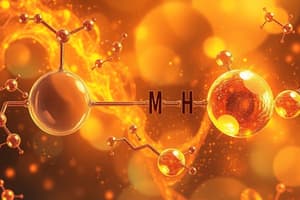Podcast
Questions and Answers
What is the correct way to determine if a compound is an aldehyde or a ketone?
What is the correct way to determine if a compound is an aldehyde or a ketone?
- Evaluate the compound based on its boiling point.
- Treat the compound with a mild oxidizing agent. (correct)
- Use infrared spectroscopy to analyze the compound.
- Treat the compound with a strong oxidizing agent.
Which of the following statements correctly describes the IUPAC nomenclature for ketones?
Which of the following statements correctly describes the IUPAC nomenclature for ketones?
- The carbon chain is numbered to prioritize the ketone group. (correct)
- The parent chain length is irrelevant in naming ketones.
- The suffix -ane is added to the parent chain.
- Ketones rank above aldehydes in nomenclature priority.
Which reaction is most commonly used for the reduction of aldehydes and ketones?
Which reaction is most commonly used for the reduction of aldehydes and ketones?
- Reduction with sodium borohydride (correct)
- Ozonolysis
- Friedel-Crafts acylation
- Hydration of alkynes
What is the primary product when an aldehyde is oxidized?
What is the primary product when an aldehyde is oxidized?
What visual evidence indicates a successful reaction using Tollens' reagent?
What visual evidence indicates a successful reaction using Tollens' reagent?
Which compound can be obtained from the Friedel-Crafts acylation reaction?
Which compound can be obtained from the Friedel-Crafts acylation reaction?
What type of alcohol do ketones get reduced to?
What type of alcohol do ketones get reduced to?
In the IUPAC system, what is the primary suffix used for naming ketones?
In the IUPAC system, what is the primary suffix used for naming ketones?
Which statement correctly describes the difference between aldehydes and ketones?
Which statement correctly describes the difference between aldehydes and ketones?
In IUPAC nomenclature, how is the terminal aldehyde group designated?
In IUPAC nomenclature, how is the terminal aldehyde group designated?
What is the recommended method for naming branched aldehydes according to IUPAC rules?
What is the recommended method for naming branched aldehydes according to IUPAC rules?
Which of the following correctly describes how aromatic aldehydes are named?
Which of the following correctly describes how aromatic aldehydes are named?
What is the significance of the Greek letter in the nomenclature of carbonyl compounds?
What is the significance of the Greek letter in the nomenclature of carbonyl compounds?
Which of the following correctly identifies the common naming convention for ketones?
Which of the following correctly identifies the common naming convention for ketones?
How does the presence of the carbonyl group affect the priority of functional groups in naming?
How does the presence of the carbonyl group affect the priority of functional groups in naming?
What is the naming convention for cyclic carbonyl compounds?
What is the naming convention for cyclic carbonyl compounds?
Flashcards are hidden until you start studying
Study Notes
Carbonyl Compounds
- Aldehydes and ketones contain a carbonyl group (C=O).
- The carbonyl carbon has two remaining bonds occupied by hydrogen, alkyl, or aryl substituents.
- Aldehydes have at least one hydrogen substituent (RCHO or RCH=O).
- Ketones have no hydrogen substituents (RCOR`).
Aldehydes
- Aldehydes are named using common names derived from the corresponding carboxylic acid.
- The ‘oic acid’ ending is replaced with ‘aldehyde’.
- The aldehyde group is always terminal.
- Substituent locations are indicated using Greek letters (α, β, γ, δ, ε, ω) starting from the α-carbon (next to the carbonyl carbon).
- Aromatic aldehydes are often named as derivatives of benzaldehyde.
IUPAC Nomenclature of Aldehydes
- The longest continuous carbon chain containing the C=O group is identified.
- The ending -e is replaced with -al.
- The CHO group is assigned the number “1” position, taking precedence over other functional groups.
- If CHO is bonded to a ring, the ring is named, and the suffix -carbaldehyde is added.
Ketones
- Ketones are named using common names by listing alkyl substituents on the carbonyl group alphabetically followed by "ketone".
- Substituent positions are indicated using Greek letters starting from the α-carbon.
- IUPAC names are derived by finding the longest chain containing the carbonyl group.
- The -e ending of the parent alkane is changed to -one.
- The carbonyl carbon receives the lower number.
- Ketone groups are named as 'oxo' substituents in aldehydes.
Preparation of Aldehydes
- Aldehydes can be prepared through various methods, including oxidation of primary alcohols, reduction of acid chlorides, and ozonolysis of alkenes.
Preparation of Ketones
- Ketones can be prepared through various methods, including hydration of alkynes, oxidation of secondary alcohols, and Friedel-Crafts acylation.
Reactions of Aldehydes
- Aldehydes undergo oxidation to carboxylic acids using oxidizing agents like potassium dichromate.
- Tollens' reagent can be used to distinguish aldehydes from ketones.
- Aldehydes are reduced to primary alcohols using reducing agents like sodium borohydride.
Reactions of Ketones
- Ketones resist oxidation by most oxidizing agents.
- Ketones are reduced to secondary alcohols using reducing agents like sodium borohydride.
Studying That Suits You
Use AI to generate personalized quizzes and flashcards to suit your learning preferences.




